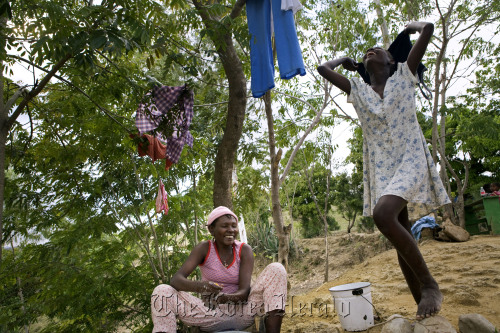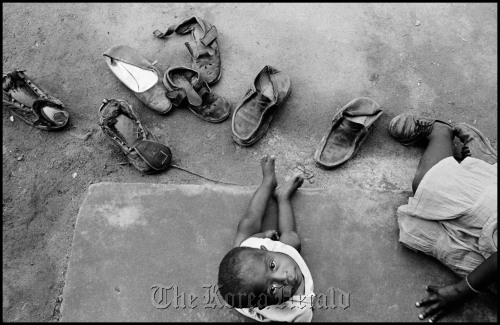Eight Magnum photographers touch hearts in ‘Access to Life’ project
Living in the scorching sun in Haiti, Autha Adolph, 26-year-old at the time, could barely stand, talk or let alone smile due to extreme malnutrition and HIV infection. She weighed only 35 kg, her limbs bony and her digestive organs practically ruined.
When she went to the hospital in November 2007, the doctors doubted that she would survive more than a few more days. Nine others who were sharing the same hospital room with her died while she was there.
But who would have guessed, that after two and a half months of treatment Adolph would be able to regain her smile? In a photo of her took in March 2008 by Jonas Bendiksen shows a gleeful girl wearing a white dress, tossing her head back and laughing, doing laundry with another woman.
 |
Haiti girl Autha Adolph (right) tosses her head back and laughs in a photo taken by Jonas Bendiksen in 2008. (Jonas Bendiksen/Magnum Photos/Eurocreon) |
“I’m here and God didn’t give me a receipt telling me how long I’ll live, but I am still here,” said Adolph, after taking the shoot.
Bendiksen said that he hoped by telling these stories and personalizing the experience, it would help other people get appropriate treatment in time.
“Antiretroviral medicines are they key to successful treatment, but they are still only one piece of the puzzle. I realized the importance of the community structure in these places as well ― ensuring that people are eating, that they are housed, that they have something to live for. That’s as important as dropping a pill in your mouth,” said the photographer.
Bendiksen and seven other renowned photographers from the Magnum Photos agency including Steve McCurry, Alex Majoli, Paolo Pellegrin, Jim Goldberg, Gilles Peress, Eli Reed and Larry Towell took before and after photos of people with HIV/AIDS who were saved from the brink of death thanks to timely treatment. They followed the patients in nine countries, including Vietnam, India and Russia, for over four months for the multimedia project “Access to Life.”
The project, a collaboration between the New York-based photography cooperative and Global Fund, which provides international financing for AIDS, tuberculosis and malaria, showcases 550 photos and nine documentary films. It arrived in Seoul after touring nine countries since 2008 and touching the hearts of over 560 million. A part of the profits made through the show so far have been donated for the treatment of over 5 million HIV/AIDS patients, providing another “access to life.”
The subjects in the “before” images are heartbreaking, appearing hopeless. Although antiretroviral drugs became available in the early 1990s and AIDS became a manageable disease, 95 percent of those living with the disease are still dying of it because they cannot afford or receive timely treatments.
The “after” photos, thankfully, are strong. They give hope to HIV patients and urge the world to send more relief to save them, reminding how big a joy each life could bring to the world, no matter how young or fragile they are.
 |
Swazi boy Tenele looks up at the camera in a photo taken by Larry Towell in 2007. (Larry Towell/Magnum Photos/Eurocreon) |
Swazi boy Tenele, at the time only 2-years-old, was unable to sit or even crawl because he was so sick, diagnosed with AIDS as an infant. In a photo took by Towell in 2007, after receiving months of treatment, Tenele is sitting up, staring into the camera with curious eyes.
“Now he can walk and even run! I am going to tell my kids that having HIV does not mean that you will die. That you can live, like Tenele,” said Siphiwe Tfumbatsi, the boy’s mother.
The exhibition runs through March 4 at Seoul Arts Center’s Hangaram Art Museum in Seocho-dong, southern Seoul. Tickets range from 5,000 won to 10,000 won. For more information, call (02) 2277-2438 or visit www.theglobalfund.org/accesstolife.
By Park Min-young
(
claire@heraldcorp.com)





![[Today’s K-pop] Blackpink’s Jennie, Lisa invited to Coachella as solo acts](http://res.heraldm.com/phpwas/restmb_idxmake.php?idx=644&simg=/content/image/2024/11/21/20241121050099_0.jpg)



